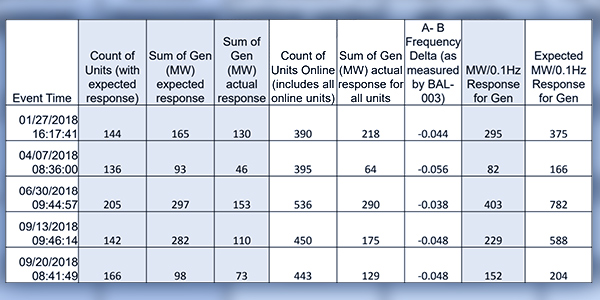VALLEY FORGE, Pa. — PJM’s Operating Committee breezed through a light agenda during its March meeting on Tuesday.
Frequency Response Performance Underwhelms
The number of generators providing primary frequency response (PFR) in 2018 fell short of PJM’s expectations, according to the RTO’s most-recently analyzed data.
Danielle Croop, PJM senior engineer of operations and analysis, told the Operating Committee PFR-capable generators didn’t respond as anticipated during five low-frequency events selected for evaluation throughout the year, at times providing less than half the megawatts PJM expected.
“These five events are the only ones that met the [PJM] criteria for 2018,” Croop said. “There’s usually about 25 or 30 events that meet [NERC’s] BAL-003, so you can see how narrow the evaluation selection is.”
At last October’s OC meeting, PJM shared frequency response data from 13 BAL-003 events between December 2017 and April 2018 that showed similar results. (See “The Right Metric on Frequency Response” in PJM Operating Committee Briefs: Jan. 8, 2019.)
PJM assesses generator performance during events in which the system frequency goes outside a +/-40-mHz deadband for 60 continuous seconds and the minimum or maximum frequency reaches +/-53 MHz. (See “Utilities Question Primary Frequency Response Calculation” in PJM Operating Committee Briefs: Feb. 5, 2019.) The five events fitting into the narrower criteria occurred on Jan. 27, April 7, June 30, Sept. 13 and Sept. 20.
While generators provided 130 MW of the anticipated 165 MW during the January event, available energy dipped to 50% or less of what PJM expected during the April 7, June 30 and Sept. 13 events.
Brock Ondayko, of AEP Energy, refuted PJM’s expectation for more output, calling it “incorrect.” He said PJM’s existing dispatch software often oversimplifies a resource’s anticipated PFR capability because it doesn’t account for physical operational hold points.
“Until PJM modifies [its] dispatch software to take into account how resources actually operate and then subsequently begins to preposition capable units to respond, ‘expected’ numbers really need to be taken with a grain of salt,” he said in an email Tuesday. “While I sympathize with PJM’s dispatch issues and understand the limitations of [its] current estimates, my continuing to bring up the topic/issues for what has seemed like years has never stopped PJM from continually sharing what must be considered suspect data, without disclaimers.”
Croop defended the numbers during the meeting Tuesday, noting more accurate data will come from analysis of individual generators — to which Ondayko agreed.
“This is not absolute … but it’s a good line in the sand to see if we are getting the PFR we are expecting or not,” Croop said. “I think more intricate details will work through at the generator evaluation level.”
Ondayko requested PJM consider accounting for future PFR sources and those scheduled for retirement, referencing FERC Order 842 requirements.
“It would give us a better sense of how successful the FERC order is going to be or not going to be,” he said.
Stakeholders Ponder Meeting Changes
As the schedule for upcoming Operating Committee meetings fills up with obligations from new and continuing task forces, stakeholders pondered getting an earlier start.
OC Chair Dave Souder suggested starting April’s meeting at 8:30 a.m. to account for agenda items related to non-retail behind-the-meter generation business rules. Stakeholders approved a problem statement and issue charge revising the existing manual language during Tuesday’s meeting. (See “PJM Continues Review of Non-retail BTM Generation Business Rules” in PJM Operating Committee Briefs: Feb. 5, 2019.)
“I think the 8:30 start time is a little early,” said Sharon Midgley, of Exelon. “And the beginning of the meeting is sometimes important, particularly if there are any controversial endorsement items.”
Jim Benchek, of FirstEnergy, agreed an earlier start time would prove difficult for stakeholders commuting and instead suggested staying an hour later.
Souder proposed implementing a working lunch for future OC meetings, to which no stakeholders voiced any objections. He said PJM’s Dave Anders also suggested moving meetings to Thursday mornings beginning in 2020 so staff could have more time to provide accurate and updated reference materials. Planning Committee meetings would occur Tuesday mornings, instead.
— Christen Smith




